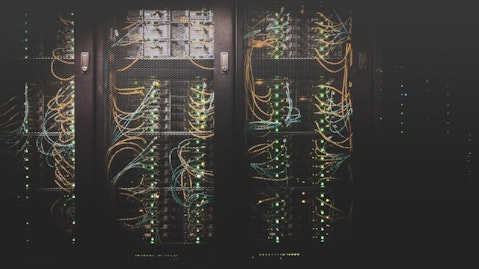In this article, we will be taking a look at the 25 countries with the highest internet penetration rates in 2023. To skip our detailed analysis, you can go directly to see the 5 countries with the highest internet penetration rates in 2023.
To the majority of the world right now, and particularly to those reading this article, life without internet is unfathomable. Nowadays, if we lose our internet connection for even a few hours, it is almost impossible to figure out how to manage, considering the fact that internet has permeated every faucet of our life. In 1995, just 1% of the global population had access to the internet, according to the World Bank. Right now, 63% of the global population has access to the internet, which translates to nearly 5 billion people using the internet. This has also helped businesses grow exponentially, and companies such as Amazon.com, Inc. (NASDAQ:AMZN) or Alphabet Inc. (NASDAQ:GOOG) would not be close to being the force they are right now thanks to the internet. Additionally, the popularity of social media has allowed brands to gain a far wider audience than possible through conventional means, at a fraction of the cost. This is why countries where social media has a heavy presence allows a company to reach a greater audience, which you can see in the countries with the most Instagram users in 2023.
However, despite its importance, internet availability, like most resources, is not available uniformly through regions, countries and cities, though the countries with the highest internet penetration rates in 2023 have been able to make full use of their infrastructure accordingly. Most of the countries which have higher internet penetration already possess the necessary infrastructure required to make internet easily available and accessible, which is where many of the biggest internet service providers in the world come into play including Comcast Corporation (NASDAQ:CMCSA), considered to be the biggest service provider in the world, while its competition includes T-Mobile US, Inc. (NASDAQ:TMUS) and Verizon Communications Inc. (NASDAQ:VZ). Often, these companies are accused of acting as monopolies as in many areas, there is only one major internet service provider operating, which doesn’t really leave any options for users and allows such companies to charge higher rates while not providing a high quality of service, which is why Internet companies sometimes form part of the most hated companies in the U.S. Surprisingly, despite the U.S. being home to some of the biggest Internet provider companies and being considered the most advanced country in the world in 2023 , it is still not among the countries with the highest internet penetration rates in 2023.

Photo by Taylor Vick on Unsplash
In fact, many such countries are located either in Europe or the Middle East. Smaller geographical locations and high levels of development make it easier to deploy and install infrastructure to provide high speed internet access. Additionally, these countries already boast advanced economies, which makes it easier for them to both use existing infrastructure and easily deploy additional infrastructure where needed. On the other hand, many developing nations don’t possess the necessary infrastructure in any capacity which is why it is often not feasible to install internet infrastructure, and where it is deployed, costs are quite high. This is why, often in developing countries, monthly internet subscription costs are often higher than those in for example, European countries and that too for a much slower speed. From personal experience, a 20MBPS internet connection in Pakistan costs $19, while a 600MBPS connection in Poland costs just $23. In other words, in a country with much better purchasing power, an internet connection 30 times faster costs just $4 more. This is also one of the reasons which explains why Pakistan is among the countries with the lowest internet penetration in the world in 2023 as most people simply cannot afford to pay for a high speed internet connection, even in areas where it’s available.
The reason that internet availability is so important is because of its direct correlation to a country’s GDP, which means you can also understand investment opportunities in a country based on internet penetration. Many studies have taken place to assess this correlation with one such study conducted by Brian Reif from Stetson University which assessed the impact of internet penetration on a country’s GDP using the Nordics, which are dominant in the list of countries with the highest internet penetration rate in 2023. The study discovered that there is a strong correlation between a nation’s GDP and internet penetration, with GDP catching up to higher internet penetration with a lag of 2-3 years. Hence, being able to assess which country is working on increasing internet penetration can provide a useful investment opportunity in that country’s ETF. The study stated in its conclusion “Presenting the correlation of 2010 GDP per capita statistics against 2010 Internet penetration rates, the scatterplot depicts that the phenomenon of countries with high GDP also having high Internet penetration was not just restricted to the Nordic region, as nearly all countries reflected strong performance in both or neither. Reflecting on the growth of each of the variables however, a pattern begins to emerge; ICT growth occurs, and as the population becomes more comfortable with the technology and more productive, the GDP level begins to increase as well. The graphs and trend analysis presented show us that this GDP growth lags two-to-three years behind the increase in Internet penetration, but the growth rates are similar, barring major global events.”
Realizing the potential of providing internet access to countries which may not have the required infrastructure is SpaceX, which launched Starlink, now operating in 60 countries and provides high speed internet through satellites. By 2025, SpaceX expects to derive over $30 billion from its satellite constellation. This was also really useful for Ukraine, when its internet services faced severe degradation as a result of Russia’s invasion, and Starlink provided Internet access, particularly to the country’s military and government. However, while internet penetration is consistently increasing even among nations which aren’t among the countries with the highest internet penetration rates, 96% of the total population which is still living offline lives in the developing world.
Something that has further helped the countries with the highest internet penetration in the world is the advent of 5G, with 5G providing download speeds up to 100 times greater than 4G. Even right now, when 5G is still in its initial phase and with a lot of potential for evolution, speeds are already incredibly fast. However, most countries still do not possess the technology required to successfully deploy 5G internet, which is why as of January 2023, less than 50 countries boasted 5G. In addition to some of the biggest internet service providers we mentioned, telecom companies, including many of the most valuable in the world such as AT&T Inc. (NYSE:T) are among the biggest providers of 5G in the world.
Methodology
To determine the countries with the highest internet penetration in the world in 2023, we have considered the countries with the highest average percentage of people with access to Internet from 2017 to 2021, the last year for which data is available, with said data obtained from the World Bank. We haven’t considered the countries with the most Internet users as that would simply indicate countries with higher populations. For example, China is the country with the most Internet users, with over 1 billion users, but internet penetration is just 73%, while the countries with the highest internet penetration in the world all have a user percentage greater than 90%. While some countries may seem to have the exact same internet penetration rate, that is because we have rounded off percentages to one decimal place.
25. Spain
Average percentage of population with internet access from 2017 – 2021: 89.7%
Spain is considered to be one of the leading countries for fibre broadband and Telefónica is pushing rural fiber rollouts in a bid to achieve 100% coverage by 2025.
24. Belgium
Average percentage of population with internet access from 2017 – 2021: 90.2%
Recently, Orange Belgium agreed a deal with rival company Telenet and is hoping that this deal will convince regulators to approve its attempted acquisition of VOO, another smaller company operating in the same industry.
23. Finland
Average percentage of population with internet access from 2017 – 2021: 90.2%
Among OECD countries, Atlas VPN’s research showed that Finland and Latvia are the nations which use the most mobile data.
22. New Zealand
Average percentage of population with internet access from 2017 – 2021: 91.1%
The government of New Zealand launched an initiative to provide internet access not just in urban but in rural areas as well. This has resulted in the percentage of the country’s population with internet access increasing by 3% in the last 6 years.
21. Hong Kong
Average percentage of population with internet access from 2017 – 2021: 91.4%
Despite most of Hong Kong’s population being able to access the internet, American tech giants are no longer catering to Hong Kong users, with both Alphabet Inc. (NASDAQ:GOOG) and OpenAI not rolling out their chatbots in Hong Kong.
20. Sweden
Average percentage of population with internet access from 2017 – 2021: 91.9%
Sweden’s telecom system’s evolution has been integral in improving internet access in the country for the last few decades, and it was one of the first countries to launch both 4G and 5G.
19. Andorra
Average percentage of population with internet access from 2017 – 2021: 92.3%
Despite Andorra being among the countries with the highest internet penetration in 2023, it has only one internet service provider which was recently temporarily taken down after a Minecraft DDoS attack.
18. Netherlands
Average percentage of population with internet access from 2017 – 2021: 92.4%
Internet availability in Western Europe is perhaps the highest of any region in the world, and the Netherlands is no exception in this case.
17. Australia
Average percentage of population with internet access from 2017 – 2021: 92.6%
While most of Australia’s population can access the internet, aging satellites owned by NBN have resulted in rural internet users struggling to remain connected to the internet.
16. Canada
Average percentage of population with internet access from 2017 – 2021: 92.9%
Despite Canada being among the countries with the highest internet penetration in 2023, Canadians’ trust in the internet has declined by 14% since 2019.
15. Switzerland
Average percentage of population with internet access from 2017 – 2021: 92.9%
Internet usage in Switzerland is sharply increasing among those over the age of 65, potentially opening up a new market for internet service providers in the country.
14. United Kingdom
Average percentage of population with internet access from 2017 – 2021: 93.0%
England recently passed a new law which means that nearly all new homes built in the country will require access to gigabit internet in a bit to expand high speed internet access in the country.
13. Liechtenstein
Average percentage of population with internet access from 2017 – 2021: 95.7%
Liechtenstein has delivered average internet speeds of around 166 Mbps, more than double Europe’s average of 71 Mbps.
12. Brunei
Average percentage of population with internet access from 2017 – 2021: 95.8%
Despite being counted among the countries with the highest internet penetration, Brunei’s government has restricted internet access for its citizens and accusations of censorship have been made as well.
11. Saudi Arabia
Average percentage of population with internet access from 2017 – 2021: 96.2%
Saudi Arabia is one of the richest countries in the world thanks to it being one of the nations with the largest oil reserves, and it has used this wealth to develop its infrastructure, including internet access.
10. South Korea
Average percentage of population with internet access from 2017 – 2021: 96.3%
South Korea achieved immense success in the last few decades to become one of the most advanced countries in the world, and high-speed internet access has played a huge part in this achievement.
9. Norway
Average percentage of population with internet access from 2017 – 2021: 97.4%
Norway has one of the highest internet speeds in the world, and has been ahead of most countries in terms of internet connectivity for the last couple of decades.
8. Denmark
Average percentage of population with internet access from 2017 – 2021: 97.6%
Internet accessibility has been available in Denmark for a long time and is one of the nations with the highest digital quality of life.
7. Luxembourg
Average percentage of population with internet access from 2017 – 2021: 97.8%
Luxembourg is one of the richest nations on the planet and is considered to be a major player in the satellite industry, and recently, Starlink has also arrived in the country.
6. Bermuda
Average percentage of population with internet access from 2017 – 2021: 98.4%
Despite having a significantly high internet penetration rate, residents of Bermuda actually pay the most for internet of anyone in the world.
Click to continue reading and see 5 Countries with the Highest Internet Penetration Rates in 2023.
Suggested Articles:
- 20 Most Influential Economists in the World
- 15 Fastest Growing Fintech Companies In 2023
- 20 Best Web Designing Tools for Developers
Disclosure: None. 25 countries with the highest internet penetration rates in 2023 is originally published on Insider Monkey.





